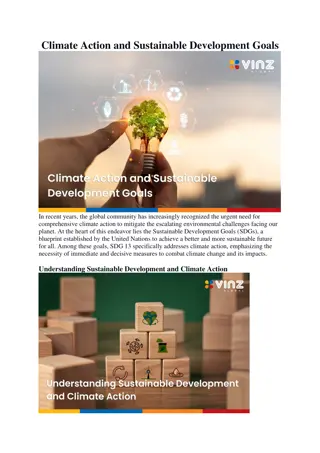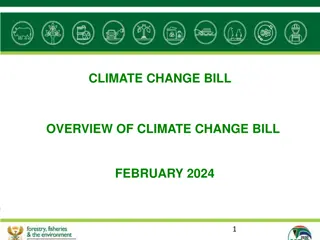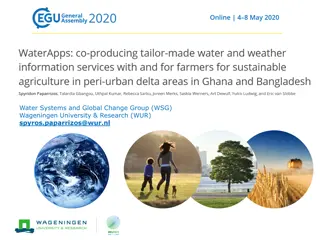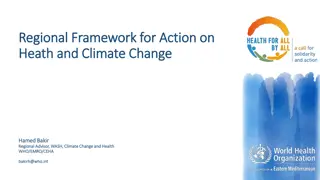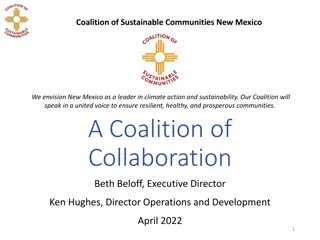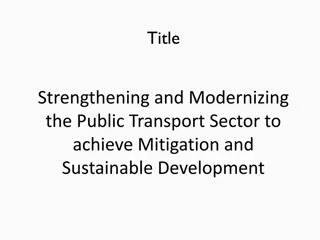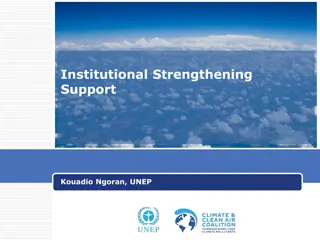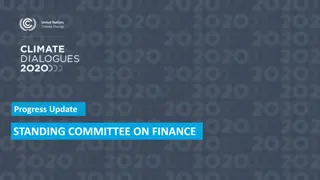National Climate Action and Sustainable Finance Strategies
Expanding on the role of financiers in NDC implementation, this content emphasizes the importance of feasible, viable, and financeable projects supported by the German Bundestag. It explores the involvement of public and private sectors in financing sustainable initiatives, highlighting barriers like low knowledge capacities and lack of financial access. The pathway from feasibility to bankability is outlined, incorporating various practices such as silvopastoral systems and organic fertilizers to overcome challenges in sustainable development.
Download Presentation

Please find below an Image/Link to download the presentation.
The content on the website is provided AS IS for your information and personal use only. It may not be sold, licensed, or shared on other websites without obtaining consent from the author.If you encounter any issues during the download, it is possible that the publisher has removed the file from their server.
You are allowed to download the files provided on this website for personal or commercial use, subject to the condition that they are used lawfully. All files are the property of their respective owners.
The content on the website is provided AS IS for your information and personal use only. It may not be sold, licensed, or shared on other websites without obtaining consent from the author.
E N D
Presentation Transcript
Supported by: based on a decision of the German Bundestag
Feasible - technically and politically Viable - under realistic assumptions, produce acceptable yields Financeable / bankable - Returns occur with a sufficient level of certainty (low risk) The importance of banks Source: S. E. L tken 2014
National climate action and NDC implementation involves a financier in a leading role In NDC action development, the leading financier is typically a domestic, public institution Freed-up cash flow or investment capital from the national budget may be used to leverage international public (donor) finance Create investment conditions and options that are attractive for the local private sector International private sector faces higher investment risks than local and usually comes last International Private National Private International Public National Public Source: S. E. L tken 2014
Map all public stakeholders Map what is already on- going in the sector Identify instruments currently employed Identify current financing sources Consider the role for the private sector, if any Source: S. E. L tken 2014
From Feasibility to bankability Structuring the finance from a wide range of potential sources to make the project bankable Source: S. E. L tken 2014
Practices 1. Implementation of silvopastoral systems 2. Introduction of biodigesters 3. Production and application of organic fertilizers Barriers Capacities: Low level of knowledge and technical ability Lack of administrative management of farms and financial knowledge Financial: Lack of access to credit
National Sources 1. DICTA was able to cover 32% of technical assistance and training with existing programs 2. 2.1 thousand USD contribution from other programs 3. Existing Investments in Field Schools International Sources 30% on concessional loans or guarantees $1.5K Training Grant International Finance (GCF) International Financial Resources Central American Bank for Economic Integration (CABEI) Resource Canalization Ministry of Agriculture and Livestock (SAG) Technical Assistance Resources, Nat & Int Directorate of Science and Technology for Agriculture and Livestock (DICTA) Technical Assistance National Financial Institutions (BANDESA BANHPROVI) Producers Concessional Loans
- International Finance Corporation Climate Resilience Pilot Project (IFC-PPCR) Low supply of sugarcane -> The processing company only operates at 75-80% of its capacity If 567 farmers implement improved practices, productivity can increase by 20% and net income by $12,000 a year Cost USD 32,000 - 95,000 Interesting for the private sector if IFC can cover 70% Increased productivity scenario Repayment period with a 70% PPCR payment as a subsidy High Cost Estimate 15.7 years Low Cost Estimation 5.3 years 2.6 years 1.8 years Low 10% 20% (baseline) 7.9 years High 30% 5.3 years
Due to the limited capital, investment in the Private Sector are primarily for their core business at the expense of investments in Energy Efficiency, even though these have average payback times of 3-4 years. No specific funds are allocated in the national budget for investments in Energy Efficiency. Banks do not lend to Energy Service Companies that could invest on client s behalf, because the assets to be procured with the loan capital are installed at the premises of the ESCOs clients and therefore not accepted by the banks as collateral. The ESCOs financial reach is therefore constrained only to their own available equity. Guarantee fund seed capital Gearing Average EPC investment EPC duration (years) Loan % of investment Interest rate loan maturity, years Equity, % of investment Guarantee coverage Default rate Default average at year Guarantee fee shared saving, % to client Mauritius ESCO Guarantee Admin costs 15,600,000 50%7,800,000 291,353 8 75% 6% 6 25% 75% 3% 3 3% 10% 1% Guarantee up to 80% will enable banks to provide loans to ESCOs. Establishment of a Revolving Guarantee Fund
Year 10 Year 11 Year 12 Year 13 Year 14 Year 15 Year 16 Year 17 Year 18 Year 19 Year 20 Year 1 Year 2 Year 3 Year 4 Year 5 Year 6 Year 7 Year 8 Year 9 Implementation Projects implemented Average Energy savings per project kWh Average financial savings per project 6 10 17 25 25 25 25 25 25 25 25 25 25 25 25 25 881,467 881,467 881,467 881,467 881,467 881,467 881,467 881,467 881,467 881,467 793,320 713,988 642,589 578,330 520,497 468,448 421,603 379,443 341,498 307,349 92,017 92,017 92,017 92,017 92,017 92,017 92,017 92,017 92,017 92,017 82,815 74,534 67,080 60,372 54,335 48,902 44,011 39,610 35,649 32,084 Direct GHG mitigation potential Loans by year 5.5 Equity by year 5.5 Total private investments by year 5.5 20,651,829 6,956,053 27,607,882 200,000 180,000 160,000 140,000 120,000 tCO2e/a 100,000 Loans by year 16 Equity by year 16 Total private investments by year 16 78,228,281 26,076,094 104,304,374 80,000 60,000 40,000 20,000 - 1 2 3 4 5 6 7 8 Year 9 10 11 12 13 14 15 16
International Finance (Mitigation Action Facility) Guarantee Fund capitalization 15,600,000 EUR Technical Assistance 828,832 EUR National Commercial Banks Applicant Support Partner (UNEP CCC) Capital Asset Management Ltd. Loans to ESCOs (80%) Fund ESCO supportive regulation Management Capacity Building Energy Service Companies Government and stakeholdders Equity (20%) and implementation Industrial Facilities and public buildings
Thank you for contributing to a brighter future Federico Antonio Canu Advisor - Finance UNEP Copenhagen Climate Centre federico.canu@un.org Supported by: based on a decision of the German Bundestag





